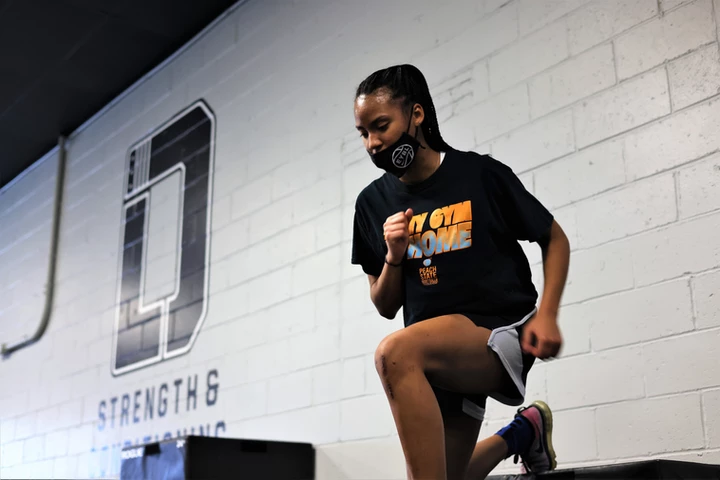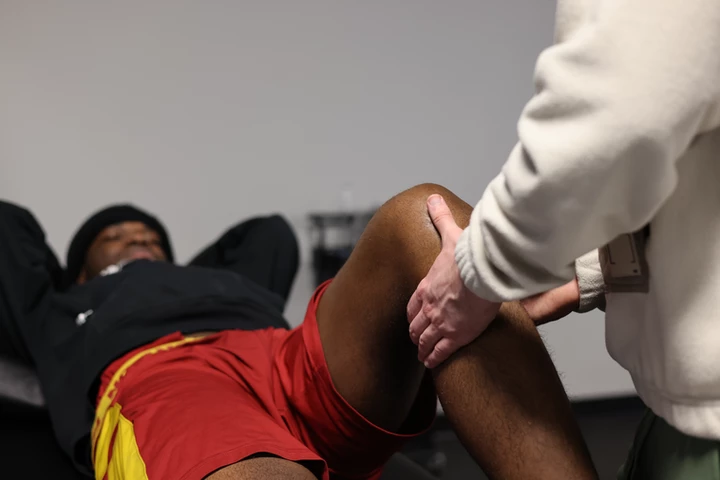Would you be shocked to learn that the knee joint is one of the most complex joints in the body? Not only does it play an important role in supporting your body weight, but it also initiates most movement. After all, you can’t get very far without bending and straightening your knee, right?
- What are Common knee injuries and how each requires different treatment approaches for effective prevention or recovery.
- Why The knee joint is complex, supporting body weight and initiating movement, making it susceptible to various injuries and sources of pain.
- How the prevention of knee injuries lies in implementing functional strengthening programs that focus on different muscle groups.
Several muscles, tendons, bones, and ligaments pass through the knee joint, which is one of the reasons why it is so complex. As such, there are many reasons why you could find yourself with an injury or pain.
Knee pain can arise from any number of sources. Sometimes, depending on the type of pain you have, it can indicate the presence of a minor strain or something more sinister.
Aside from the occasional ache or twinge of knee pain, what should concern you as an active individual? Well, let’s take a look at some of the most common knee injuries and expectations for recovery. At the end of the article, we’ll discuss knee injury prevention from the perspective of a doctor of physical therapy.
Anterior Cruciate Ligament (ACL) Injuries
Ah, the infamous ACL. If you’re a sports fan or an avid athlete, then you’ve likely heard about ACL injuries. In fact, they make up nearly 40% of all sports-related injuries.
The ACL is found inside the joint and keeps your shinbone from shifting forward on the thigh bone. Simply put, the ACL is a major stabilizer for the knee.
A quick “plant and twist” of the leg is all it takes to stress the ACL and cause immediate damage. Sudden deceleration, a rapid change in direction, or landing awkwardly from a jump also compromises the ACL. That’s why many ACL injuries frequently occur in sports that involve cutting and pivoting, like football, soccer, or lacrosse.
When the ACL is damaged, a partial or complete tear of the tissue can occur. A mild ACL injury stretches the ligament without actually tearing it. Regardless of the severity, you’ll likely experience the following:
- A distinct “pop”
- Immediate swelling around the knee
- Severe knee pain
- Knee instability of the feeling of the knee “giving out”
- Inability to continue an activity
Treatment for ACL injuries depends on a few factors. A complete ACL tear (also known as a rupture) usually requires surgery, especially if you hope to return to athletics. Less severe ACL injuries or incomplete tears can be conservatively managed with physical therapy.
Collateral Ligament Injuries
Along the inside and outside of your knee joint are two collateral ligaments known as the medial and lateral collateral ligaments (yes, it’s a mouthful!). The medial collateral ligament (MCL) runs along the inside of your knee whereas the lateral collateral ligament (LCL) is found along the outside.

Like the ACL, the collateral ligaments can be injured during activities that involve bending, twisting, or cutting. Specifically, the MCL is vulnerable to impact on the outside (lateral side) of the knee. In contrast, the LCL is injured when forces strike the inside (medial side) of the knee. LCL injuries are much less common as MCL injuries are frequently associated with ACL tears.
Depending on which side is injured, you’ll experience acute knee pain directly over the ligament itself. The knee may swell or bruise and feel unstable when standing, walking, or climbing stairs. Later on, it will become harder to bend and straighten the knee, which is often mistaken as stiffness.
Treatment for collateral ligament injuries includes conservative management with physical therapy to strengthen the muscles that support the knee. Surgery isn’t always necessary, but when there are other structures involved – like the ACL or meniscus – then it becomes a part of the conversation.
Knee Dislocations
A dislocation occurs when a bone slips out of alignment and requires a manual force to be put back into place. When it comes to knee dislocations, the knee cap (patella) is the biggest area of concern.
Patella dislocations happen when the knee cap pops out of its groove, usually towards the outside of the leg. Most often as a result of a high-impact fall or a sports collision, this is another obvious knee injury since you’ll lose the ability to walk. On rare occasions, the knee joint will lock in place and cause ligament damage, especially if the body is still moving.
Although painful, treatment for a patellar dislocation is relatively uncomplicated. A trained professional can quickly reduce the dislocation – aka put it back in place – and may recommend physical therapy to strengthen the surrounding area and prevent future knee dislocations.
Knee Fractures
Knee fractures may result from a fall on the knee, collision, or car accident that forces the joint against the dashboard. A fracture can be an uncomplicated and clean break or, worse, the bone can fragment into many pieces.
The most commonly fractured bone in the knee joint is the knee cap (patella) due to its location on the surface of the joint. However, the thigh and shin bones (femur and tibia) can also sustain fractures depending on the mechanism of injury. While less common, patellar fractures can also result from indirect trauma, such as the strong pull of the quadriceps muscle.
A patellar fracture is a serious injury that makes it nearly impossible to straighten the knee and, therefore, walk. In some situations, the knee cap can splinter into several pieces upon impact. Immediate swelling and intense knee pain are key indicators that you’re dealing with a potential fracture.
Knee fractures should always be evaluated by a physician as soon as possible to determine the next move. Simple patellar fractures can be treated conservatively by wearing a cast until the bone heals. For more severe fractures, surgery may be necessary to stabilize the knee cap and restore normal movement.
Knee Meniscus Injuries
The meniscus is a piece of cartilage in your knee joint that sits between the thigh and the shin bones. Its main purpose is to absorb the impact to protect the surface of the bones from rubbing together.
Most knee meniscus injuries take place while twisting, cutting, pivoting, or jumping. Understandably, it should come as no surprise to learn that the ACL and meniscus are frequently injured together since they’re both vulnerable to athletic movements. Furthermore, as we get older, the meniscus wears down and becomes easily prone to injury.
Cardinal signs of a potential meniscal tear are:
Swelling that increases with activity and weight-bearing
Knee pain at the side or center of your knee
Stiffness with movement but can tolerate walking
In some cases, feeling like your knee is locked, catching, or popping
Like other knee injuries, meniscal tears are treated according to severity. The type of tear, location of the injury, and age will affect your treatment options. Surgery may be recommended to repair or remove some (or all) of the meniscus.
Did you know that the majority of meniscal tears do not require surgery? With the right physical therapy program, you can return back to your fitness activities or sports with no limitations.
Patellar Tendinitis
The patellar tendon, also known as the quadriceps tendon, connects your quadriceps muscles to your shin bone. The patella (knee cap) sits underneath it, hence the name.
Patellar tendon injuries most often occur during sports that require jumping, like basketball, volleyball, or track and field. Combined with limited rest breaks from playing, repetitive movements irritate the patellar tendon and lead to a buildup of inflammation. This results in patellar tendinitis – coined “jumper’s knee,” to no surprise.
Signs and symptoms of patellar tendinitis include tenderness or dull pain over the knee cap that increases with jumping and running. Because tendinitis is an overuse injury, your knee pain may initially appear only during exercise or just after a hard workout. However, patellar tendinitis can worsen over time and interfere with everyday activities, like climbing stairs.
Rather than ignore the symptoms, we encourage you to seek treatment quickly as waiting will only increase the severity of the injury. If left untreated, patellar tendonitis can eventually cause further harm to the tendon.
Treatment for patellar tendinitis involves:
- Activity modification because rest is not the answer. Having a game plan to stay active is!
- Ice after activity to prevent further inflammation
- Knee strengthening exercises, particularly for the quadriceps muscles (but don’t neglect the hamstrings)

Knee Injury Prevention and Recommendations from a Doctor of Physical Therapy
No one wants to get hurt and, between multiple doctor visits and physical therapy treatments, knee injuries can become quite costly.
But promising research in physical therapy tells us how to prevent knee injuries and reduce knee pain. Here’s what you should know.
To prevent knee injuries and future episodes of knee pain, focus on functional strengthening programs that are multifaceted and include a variety of exercises. Knee prevention exercises should include these key components:
- Strengthening for the quadriceps and hamstrings
- Hip mobility and stability
- Glute strength
- Core stability
- Ankle range of motion
- Plyometric exercises
One recent clinical practice guideline recommends a combination of dynamic flexibility stretches, speed drills, and core strength exercises during preseason conditioning or before competitive events to lower the risk of knee injuries in sports. Knee injury prevention programs are strongly encouraged for athletes ages 12 and 25 years and especially female athletes due to their increased risk for ACL injuries.
When these tips and tricks aren’t cutting it for you, don’t hesitate to reach out to the doctors of physical therapy at Myokinetix Physical Therapy and Performance, a premier physical therapy clinic in Morris County, New Jersey. Call 973-585-4990 for an initial consultation at our convenient clinic in East Hanover.
References
Exercise for Knee Injury Prevention: A Summary of Clinical Practice Guideline Recommendations Using the Evidence to Guide Physical Therapist Practice. (2018). The Journal of Orthopaedic and sports physical therapy, 48(9), 732–733. https://doi.org/10.2519/jospt.2018.0508
Knee Injury Prevention: Exercises to Keep You From Getting Sidelined. (2018). The Journal of Orthopaedic and sports physical therapy, 48(9), 734. https://doi.org/10.2519/jospt.2018.0508

Thanks so much for really informative article
My cousin plays for his school’s volleyball team, but he’s been off his game for a while now since his knee keeps hurting, so he is hoping to have it checked soon. It was a helpful piece of advice when you recommended focusing on functional strengthening programs if we don’t want future episodes of knee pain and to prevent knee injuries from occurring since it involves strengthening the quadriceps and hamstrings, along with hip mobility and stability. I’ll keep this in mind while I help my cousin find a physical therapist in Philadelphia to contact about knee pain therapy before his next big game.
Hi Clare! Thank you for your feedback on our blog; we’re glad you found it helpful. If you would like more information, please give us a call at 973-585-4990